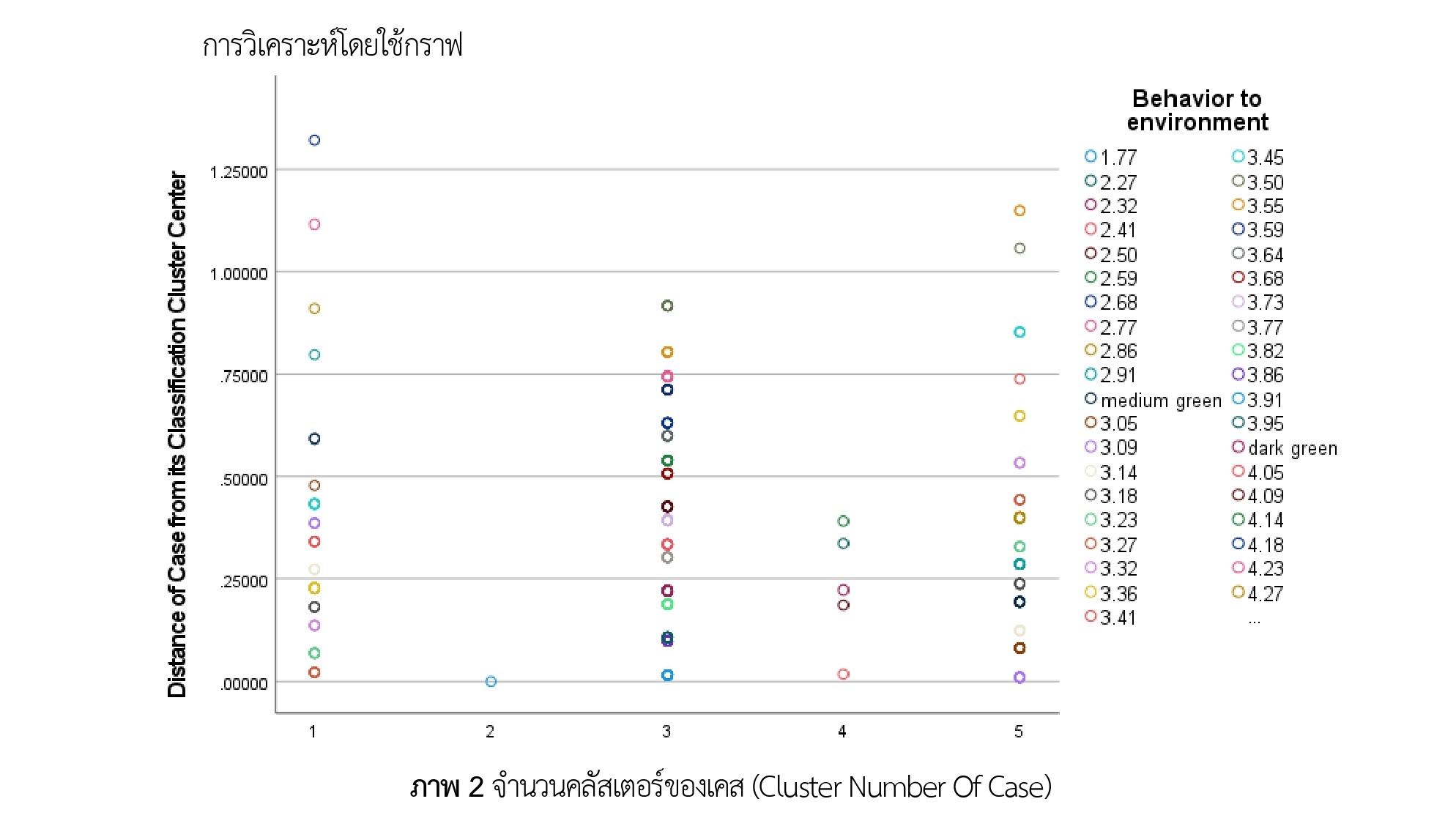Cluster Analysis of Environmental Responsibility Behavior among Thai Youths
DOI:
https://doi.org/10.14456/psruhss.2024.12Keywords:
Cluster analysis, Environmental responsibility behavior, Thai youthsAbstract
The objective of this research is to study environmental responsibility behavior when visiting natural areas among Thai youths. Using online data collection method from 485 Thai population aged between 19-25 years old. The result indicated that most of Thai youth had a full performance environmental responsibility behavior. By conducting K-means Cluster Analysis with K = 5, there could be segmented into five groups with the explicit differences of behaviors. 1) The very light green group was the least number, accounting for 0.20 percent of the sample. This group is a group that does not practice environmentally responsible behavior at all, indifferent to the environment, and have the lowest level of environmentally responsible behavior. 2) The light green group, accounting for 1.03 percent of the sample group. This group is a group that practices some environmentally responsible behavior. Some care about the environment and have a low level of environmental responsibility behavior. 3) The green group accounted for 12.17 percent of the sample group. This group is a group that practices environmentally responsible behavior infrequently, care about the environment infrequently, and have moderate environmentally responsible behavior. 4) The dark green group had the highest number, accounting for 61.03 percent of the sample group. This group often acts as an environmentally responsible behavior group. Always pay attention to the environment and have a high level of environmental responsibility behavior. 5) The very dark green group representing 25.57 percent of the sample group. This group is a group to practice responsible behavior on the environment on a regular basis. Always pay attention to the environment and have the highest level of environmentally responsible behavior.
References
Bateman, J. (2020). NOAA finds ocean heat content was the highest in recorded history. NOAA (National Oceanic and Atmospheric Administration U.S. Department of Commerce). Retrieved May 12, 2022 from https://www.noaa.gov/news/2019-was-2nd-hottest-year-on-record-for-earth-say-noaa-nasa
Dolnicar, S., Crouch, I., G., & Long, P. (2008). Environment-friendly Tourist: What Do We Really Know About Them?. Journal of Sustainable Tourism, 16(2), 197-210.
Elkington, J., & Hailes, J. (1988). The Green Consumer Guide. London: Victor Gollancz.
Green Network. (2021). Retrieved August, 22, 2022 from https://www.greennetworkthailand.com
Hair, J. F., Black, W. C., Babin, B. J, Anderson, R., & Tathum, R. (2006). Multivariate Data Analysis (6th ed.). Upper Saddle River: Prentice Hall.
Haws, K. L., Winterich, K. P., & Naylor, R. W. (2014). Seeing the world through GREEN-tinted glasses: Green consumption values and responses to environmentally friendly products. Journal of consumer psychology, 24(3), 336-354. https://doi.org/10.1016/j.jcps.2013.11.002
Jackson, T. (2004). Motivating sustainable consumption: A review of evidence on consumer behavior and behavioral change. London: Policy Studies Institute. Report to the Sustainable Development Research Network.
MacMillan, A., & Turrentine, J. (2021). Global Warming 101. NRDC (Natural Resources Defense Council). Retrieved May 12, 2022 from https://www.nrdc.org/stories/global-warming-101#warming
McDonald, S., Oates, C., Alevizou, P. J., Young, W. & Hwang, K. (2006) Communication strategies for sustainable technologies: Identifying patterns in consumer behavior. Paper presented at Greening of Industry Network’s 13th International Conference Interaction and Communication: A Clear Route to Sustainability. 2-5 July, University of Cardiff.
Mintel Group. (1994). The Green Consumer: The Green Conscience. London: Mintel International.
Office of the National Economic and Social Development Council (NESDC). (2010). National Economic and Social Development Plan Issue 11 (2011-2016). Prime Minister's Office. (in Thai)
Office of the National Economic and Social Development Council (NESDC). (2016). National Economic and Social Development Plan No. 12 (2017-2021). Prime Minister's Office. (in Thai)
Ottman, J. A. (1992). Industry's response to green consumerism. Journal of Business Strategy, 13(4), 3-7.
Peattie, K. (2001). Towards sustainability: The third age of green marketing. The marketing review, 2(2), 129-146.
Risbey, J. S., O'Kane, T. J., Monselesan, D. P., Franzke, C. L., & Horenko, I. (2018). On the dynamics of austral heat waves. Journal of Geophysical Research: Atmospheres, 123(1), 38-57. https://doi.org/10.1002/2017JD027222
Rovinelli, R. J., & Hambleton, R. K. (1977). On the Use of Content Specialists in the Assessment of Criterion-Referenced Test Item Validity. Tijdschrift Voor Onderwijs Research, 2, 49-60.
Weaver, D. B. (2002). Hard-core Ecotourist in Lamington National Park. Australia. Journal of Ecotourism, 1(1), 19-35.
Weaver, D. B., & Lawton, L. J. (2002). Overnight Ecotourist Market Segmentation in the Gold Coast Hinterland of Australia. Journal of Travel Research, 40(3), 270-280.
Witherspoon, S. (1994). The Greening of Britain: Romance and Rationality. In: R. Jowell, J. Curtis, L. Brook and D. Ahendt (eds.) British Social Attitudes: The 11th Report (pp. 107-139). Aldershot, UK: Dartmouth.
Yamane, T. (1973). Statistics: An Introductory Analysis (3rd ed.). New York: Harper and Row.

Downloads
Published
How to Cite
Issue
Section
License
Copyright (c) 2024 Humanities and Social Sciences Journal of Pibulsongkram Rajabhat University

This work is licensed under a Creative Commons Attribution-NonCommercial-NoDerivatives 4.0 International License.
Any articles or comments appearing in the Journal of Humanities and Social Sciences, Rajabhat Phibulsongkram University, are the intellectual property of the authors, and do not necessarily reflect the views of the editorial board. Published articles are copyrighted by the Journal of Humanities and Social Sciences, Rajabhat Phibulsongkram University.








